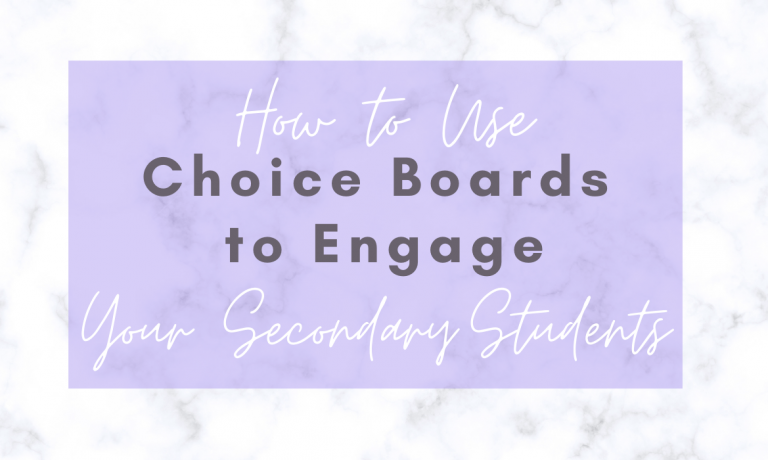If you are having trouble reaching the diverse learners in your math classroom, choice boards are for you! It is important to give students choice in the secondary math classroom. By giving choice to students, they will be more engaged, you’ll learn more about their learning styles, and it will make differentiating a breeze.
I have been using choice boards in both my pre-algebra and Algebra 1 classes for a few years now and have seen great academic success and higher engagement with my students. I will continue to use choice boards for all my future math classes!
What are Choice Boards?
Choice boards are a graphic organizer that allows students to choose what and/or how they want to practice a certain concept. They can look like a grid with various problems on it, or they can be leveled tasks. They can look different from one another, but all have the same effect.
You may have heard choice boards be called something else in the education world, like Learning Menus or Think Tac Toe. What these different types of choice boards have in common is that they give students a chance to show off their learning style and level of knowledge.
How Do Choice Boards Work?
Choice boards work in a variety of ways. My favorite way to use them in my classroom is to offer students a large number of choices as either tasks or problems, then assign a certain number of those tasks or problems for students to complete. The best part about this is that your students choose which problems or tasks that they want to or can complete – hello differentiation!
My favorite way to assign a choice board is with a three by five (3 x 5) grid. I make each column a different skill or level and assign students a set number of problems to complete. If I make a choice board where each column is a different skill, I make each row a different level. For example, with my Simplifying Expressions Choice Board, the first column has students combining like terms, another column to practice distributive property, and the last column to general simplify algebraic expressions. The first row has very basic problems. Each row after that contains problems that get progressively more difficult.
How to Use Choice Boards in Your Math Classroom
Choice boards are very versatile. They can be given as individual practice, a station in math workshop rotation, or even as homework. I have used them in all three ways. And none have yet to fail me! Choice boards are the perfect way to differentiate your content. The possibilities are truly endless with how you can use choice boards in your math classroom!
Independent Practice
Typically, I give a short lesson and then let them work on a choice board for the remainder of class. When I do assign a choice board for this, I give them a large amount of problems and have them complete a select few. For example, when I teach solving algebraic proportions, I do a mini lesson, then assign a 15 problem choice board. Students would only be required to complete 9-12 problems. Depending on the student, I may go around and star select problems that specific students should do before choosing other problems to complete.
This works really well because I am on a block schedule, but this could also work on a 30-45 min class schedule as well. If you are not on a block schedule, I would suggest having fewer problems. Again, choice boards provide a lot of flexibility. There is no set way on how to use them in your math classes. So change how you assign them based on your classes needs.
Station Work
I love teaching with the math workshop model. Choice boards are perfect to use in a station rotation. You could structure your stations using a tic tac toe style choice board. For example, you could fill a three by three (3 x 3) grid with activities for students to complete. I suggest making the center activity a “must do” for all students and then have them complete any other two tasks that results in getting three in a row. Be sure that no matter which way a student creates tic tac toe, they are not doing an activity more than once.
Choice boards can also be used as one of the stations in your station rotation. As long as you make the directions clear as to how many problems they should do, students can work independently. You could also use a choice board as a small group teacher station. The teacher would go over select problems with students based on their level of understanding.
Homework
When I originally started assigning students choice boards as homework, I was requiring them to finish what they started in class. I figured, “why can’t they complete them at home?” More students were actually getting homework done on a more consistent basis than just assigning a boring worksheet with a ton of problems. I also would tell students that if they want more practice, they could do more problems than were assigned. Parents, students, and myself included were all on board with assigning choice boards for homework.
Now that you have read all about choice boards and how to use them, feel free to check them out at my store or my Teachers Pay Teachers store.





One Response